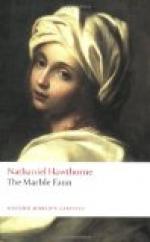The Italian climate, moreover, robs age of its reverence and makes it look newer than it is. Not the Coliseum, nor the tombs of the Appian Way, nor the oldest pillar in the Forum, nor any other Roman ruin, be it as dilapidated as it may, ever give the impression of venerable antiquity which we gather, along with the ivy, from the gray walls of an English abbey or castle. And yet every brick or stone, which we pick up among the former, had fallen ages before the foundation of the latter was begun. This is owing to the kindliness with which Natures takes an English ruin to her heart, covering it with ivy, as tenderly as Robin Redbreast covered the dead babes with forest leaves. She strives to make it a part of herself, gradually obliterating the handiwork of man, and supplanting it with her own mosses and trailing verdure, till she has won the whole structure back. But, in Italy, whenever man has once hewn a stone, Nature forthwith relinquishes her right to it, and never lays her finger on it again. Age after age finds it bare and naked, in the barren sunshine, and leaves it so. Besides this natural disadvantage, too, each succeeding century, in Rome, has done its best to ruin the very ruins, so far as their picturesque effect is concerned, by stealing away the marble and hewn stone, and leaving only yellow bricks, which never can look venerable.
The party ascended the winding way that leads from the Forum to the Piazza of the Campidoglio on the summit of the Capitoline Hill. They stood awhile to contemplate the bronze equestrian statue of Marcus Aurelius. The moonlight glistened upon traces of the gilding which had once covered both rider and steed; these were almost gone, but the aspect of dignity was still perfect, clothing the figure as it were with an imperial robe of light. It is the most majestic representation of the kingly character that ever the world has seen. A sight of the old heathen emperor is enough to create an evanescent sentiment of loyalty even in a democratic bosom, so august does he look, so fit to rule, so worthy of man’s profoundest homage and obedience, so inevitably attractive of his love. He stretches forth his hand with an air of grand beneficence and unlimited authority, as if uttering a decree from which no appeal was permissible, but in which the obedient subject would find his highest interests consulted; a command that was in itself a benediction.
“The sculptor of this statue knew what a king should be,” observed Kenyon, “and knew, likewise, the heart of mankind, and how it craves a true ruler, under whatever title, as a child its father.”
“O, if there were but one such man as this?” exclaimed Miriam. “One such man in an age, and one in all the world; then how speedily would the strife, wickedness, and sorrow of us poor creatures be relieved. We would come to him with our griefs, whatever they might be,—even a poor, frail woman burdened with her heavy heart,—and lay them at his feet, and never need to take them up again. The rightful king would see to all.”




